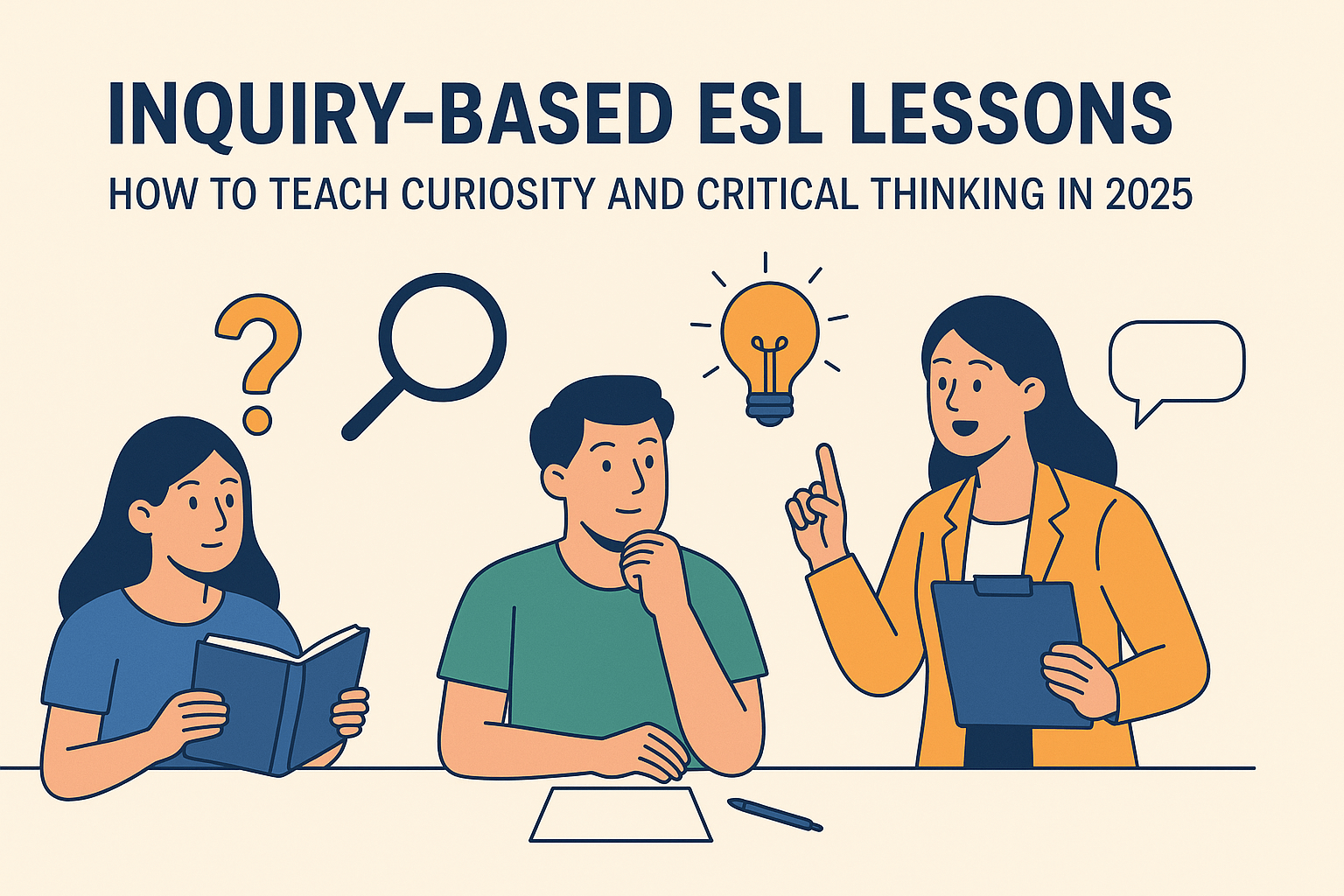Today’s ESL classrooms are changing. Teachers are no longer just giving answers—they’re helping students ask better questions. One of the best ways to do this is by using inquiry-based ESL lessons. This method is perfect for encouraging curiosity, creative thinking, and real-world communication.
In this blog, we will explain what inquiry-based learning is, how it works in ESL classrooms, and give you simple ideas to start using it. Let’s help your students become confident, curious learners!
What Is Inquiry-Based Learning (IBL)
Inquiry-Based Learning (IBL) is a student-centered teaching method where learners explore topics by asking questions, doing research, and solving problems. Instead of just listening to the teacher, students work together to find their own answers.
In simple terms, it’s about learning by asking.
This is very different from the traditional “lecture and memorize” style. In IBL, students are active participants. They ask questions like:
-
Why do people celebrate different festivals?
-
How does climate change affect our world?
-
What makes a great invention?
Then they explore the answers in English, using speaking, reading, writing, and listening skills.
Why Use Inquiry-Based ESL Lessons
Here are some clear benefits of using IBL in ESL classrooms
| Benefit | Description |
|---|---|
| Builds Thinking Skills | Students learn how to ask questions and find answers. |
| Improves Communication | Learners talk, listen, and present ideas using English. |
| Connects to Real Life | Topics are meaningful and related to the world around them. |
| Increases Motivation | Students feel curious and excited to discover more. |
Teachers are now focusing more on critical thinking and real-life communication, which are essential in 2025. Inquiry-based lessons are a powerful way to build these skills.
Simple Framework for Inquiry-Based ESL Lessons
Here’s an easy 5-step process to plan your own IBL lesson
1. Start with a Big Question
Choose a topic your students care about. Ask a simple but open-ended question like:
-
Why do we need clean water?
-
What would life be like without electricity?
2. Explore and Research
Let students read, watch videos, or ask others. Provide simple English materials. Use tools like:
-
Ellii – Ready-made ESL lesson plans
-
News in Levels – Easy English news articles
3. Group Discussion
Students talk in pairs or small groups to share what they learned. Encourage them to use phrases like
-
I think… because…
-
What do you mean?
-
Can you explain more?
4. Create Something
Let students create a short presentation, a poster, a role-play, or a simple report in English.
5. Reflect and Share
Finish the lesson by asking students
-
What did you learn today?
-
What question do you still have?
Example Inquiry-Based ESL Lesson Why Do People Migrate
Big Question
Why do people move from one country to another?
Explore
Give students articles or short videos about migration. Use simplified materials or create a vocabulary list with words like “immigration,” “refugee,” “job opportunities,” and “education.”
Discuss
Students talk about reasons people move. They can give examples from their own country or personal experience.
Create
Ask groups to create a simple poster showing reasons people migrate, using English phrases and pictures.
Reflect
Students share their posters and reflect on what they learned about migration and people’s lives.
Tips for Making IBL Work in ESL Classrooms
-
Keep the Language Level Right
Use easy English so students don’t feel overwhelmed. You can pre-teach key vocabulary. -
Support with Visuals
Pictures, charts, videos, and infographics help students understand the topic better. -
Encourage Teamwork
Working in groups helps students learn from each other and feel less shy. -
Be a Guide, Not a Giver of Answers
Your job is to guide, not give all the answers. Ask more questions like “What do you think?” or “Can you find out more?” -
Use Technology Tools
Interactive tools make lessons more fun and engaging:
-
Padlet – for brainstorming ideas
-
Canva – for student poster creation
-
Kahoot – to review vocabulary in a fun way
How Inquiry-Based ESL Lessons Match Global Trends
According to Ellii’s 2025 ELT trends, there is a big focus on:
-
Critical thinking
-
Global citizenship
-
Student choice and voice
Inquiry-based learning fits all of these. It helps students think deeply, learn about real-world issues, and speak up with their own ideas.
Is IBL Only for Advanced Students?
No! Even beginner or lower-intermediate ESL learners can benefit from IBL. The key is to:
-
Choose familiar topics (food, daily life, community, environment)
-
Provide sentence frames and vocabulary support
-
Use visuals and simplified texts
For example, you can ask:
“What makes a healthy lunch?”
And give choices, pictures, or menus for students to explore and create their answers.
Final Thoughts: Inquiry Creates Lifelong Learners
Inquiry-Based ESL Lessons are more than a trend—they’re a pathway to real learning. In 2025, language skills alone are not enough. Students need to ask good questions, solve problems, and express their ideas clearly in English.
When we help students explore and discover, we are not just teaching English—we are helping them grow as thinkers, global citizens, and future leaders.
FAQ Section
Q1: Can I use inquiry-based learning with young learners?
Yes! Just keep topics simple and use visual aids like flashcards, stories, and drawings.
Q2: What are good topics for inquiry-based ESL lessons?
Try topics like health, travel, technology, climate change, food, or jobs. Choose what fits your students’ interests.
Q3: Do I need internet access to teach IBL?
Not always. You can use printed materials, pictures, and classroom discussions to create a great IBL experience.


